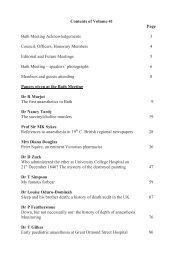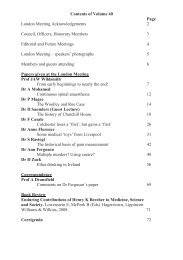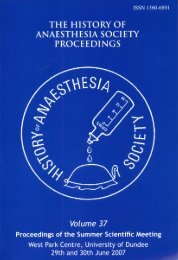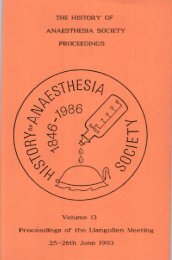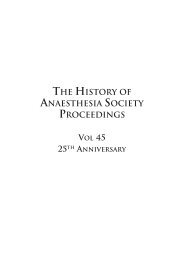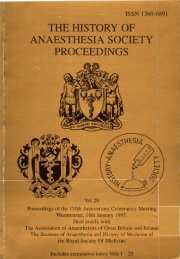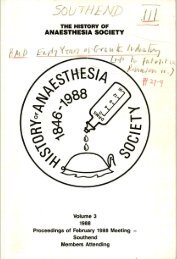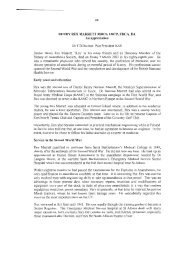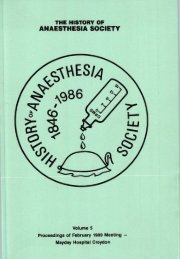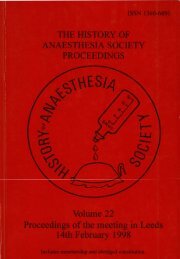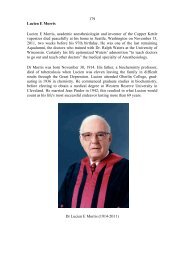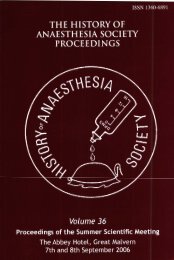3 - History of Anaesthesia Society
3 - History of Anaesthesia Society
3 - History of Anaesthesia Society
You also want an ePaper? Increase the reach of your titles
YUMPU automatically turns print PDFs into web optimized ePapers that Google loves.
than 170 in 1991. TCIe EARS holds reqular meetings and conferences and<br />
has p-lrticipated in scientific events in th? USSR and also abroad. me<br />
first direct international contacts were establis'lsd with the Finnish<br />
Anae~thesiologists <strong>Society</strong> i~ 1958, but after the first two joint<br />
meetings, the plitical insistence on cultural isolation from the<br />
western world stow contacts until 1988. Closa contact.^ have always<br />
been maintained with the btvian and Lithl~nian Anaesthesiolgists-<br />
Reanimatoloyists Societies. lie have held regular weekend Smmer meetings<br />
t:~roughout our country from 1969 to the present time. In 1969 sane <strong>of</strong><br />
the leading anaesthetists in Estonia organised a systemtic study <strong>of</strong> the<br />
'state <strong>of</strong> the art' <strong>of</strong> intensive care in surgical hospitals,. This led to<br />
the setting up <strong>of</strong> a regul~ postgraduate course in hsic elements <strong>of</strong><br />
intensive care given to doctors <strong>of</strong> all speci?lties at Tartu University.<br />
Since 1975, advanced training and specialisation in anaesthesia and<br />
intensive care has been provided by Tartu University Hospital within the<br />
framewrk <strong>of</strong> an internship proqramne consisting <strong>of</strong> one year for<br />
specialisation after six years at medical school. Up to this time the<br />
<strong>of</strong>ficial requirement for anaesthesia training was only five months.<br />
Teaching anaesthasia and intensive care to medical underqraduat?s by<br />
specialists in Tartu University dates back to the end <strong>of</strong> the 1950's but<br />
<strong>of</strong>ficial recognition <strong>of</strong> our specialty was not received until 1976, when<br />
the Department <strong>of</strong> General Surgery a t the rledical Faculty was reorqanised<br />
into Depilrtments <strong>of</strong> Anaest!lesiology, Reanimatoloqy and General !jurqery.<br />
Ihe influ?me <strong>of</strong> basic anaesthetic textboaks<br />
mis reimrkhle era <strong>of</strong> establishment <strong>of</strong> a new medical spcialty in<br />
Estonia began in conditions <strong>of</strong> strict cultural isolation from all<br />
Western influences .in the beqinrling <strong>of</strong> the 1350's. It is <strong>of</strong> interest to<br />
follow some lines <strong>of</strong> medical thouqht which influenced this developnent.<br />
In t!!e 50's an extensive overeqhasis on neuroreflectory theories<br />
occurred in virtually every branch <strong>of</strong> mwicine due to the great<br />
poplarity in t!e Soviot Union <strong>of</strong> H Labrit and 0 Huguenard's<br />
publications abut hibrnothera.~ and the need for autonanic protection<br />
and stabilisation. mis lead to the widespread use <strong>of</strong> p'lenothiazines<br />
inllytic cocktails', aid the popllarity <strong>of</strong> so-called 'ptentiation' in<br />
anaesthesia. A high canplication rate, which followed this deep<br />
depression <strong>of</strong> autoregulstory mechanisms soon led to its abandonwnt.<br />
Pco'wbly as some form <strong>of</strong> rnental colmteraction, there folloi~ed a brief<br />
pried <strong>of</strong> popularity in the middle 60'3, <strong>of</strong> very li-qht levels <strong>of</strong> general<br />
endotrac'7eal anaesthesia ilenoting t!~e stage <strong>of</strong> analgesia, as ppularised<br />
by J F Wtusio. .h unacceptable number <strong>of</strong> patients complsining <strong>of</strong><br />
awareness and r?collection <strong>of</strong> events in t!?e operating room soon<br />
tenninatd this em. FYm the second half <strong>of</strong> the 601s, ~ith the more<br />
refplar deliveries <strong>of</strong> =stern anaest:~etic literature, the practice <strong>of</strong><br />
anaesthesia and intensive care berme more in line with contemporary<br />
world practice. Unfort~lnately, there still remain severe restrictions in<br />
the choice <strong>of</strong> snaezthetic dmgs and there is a lack <strong>of</strong> cont,mpo-rary<br />
equipnent which continues to hamper our specialty's developnent.<br />
Hopefully, in th.2 plitically new climate now emerging in Furr~e, there<br />
are prs&xctives for radical changes to take pl~ice.



